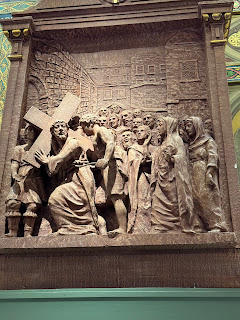O God, who in this season give your Church the grace to imitate devoutly the Blessed Virgin Mary in contemplating the Passion of Christ, grant, we pray, through her intercession, that we may cling more firmly each day to your Only begotten Son and come at last to the fullness of his grace.
This alternative collect for today is all that remains of the feast of the Seven Sorrows of the Blessed Virgin Mary (Septem Dolorum Beatae Mariae Virginis) that for centuries was celebrated on this Lenten Friday. (A second feast of the Seven Sorrows still survives, somewhat renamed, on September 15.)
Formerly, the Fridays of Lent used to be cluttered with a number of particular passion-related feasts permitted pro aliquibus locis, but the Seven Sorrows – a medieval feast focused especially on Mary’s compassion at the foot of the cross – was the only one which eventually made it into the universal calendar, which it did in 1727. The duplicate feast in September – originally proper to the Servite order – made it into the universal calendar in 1814, and was more focused on the (traditionally seven) sorrows of Mary throughout the course of her life, from the prophecy of Simeon to Jesus’ burial. Distinctive to both feasts was the special sequence Stabat Mater by Giacopone da Todi (1306), which Pius Parsch acknowledged as « certainly one of the finest religious poems from the Middle Ages. » Fortunately for the Stabat Mater – and thus for us – that sequence still survives especially in the popular Lenten devotion of the Way of the Cross, where its verses are traditionally sung by the congregation as processional music while walking from Station to Station, in the intervals between the 14 Stations. The Stations just would not be same without it! And the familiar and easily singable popular tune to which it is typically sung also lends itself, by its familiarity, to congregational participation even when the physical circumstances of the place preclude everybody actually joining in the walk from station to station.
It is, of course, of more than antiquarian interest among liturgical enthusiasts that the reformed Missal laudably retains this Marian collect today. In these last two weeks of Lent (traditionally termed Passionatide) the liturgy’s focus very visibly shifts from penitential preparation for initiation and/or penitential preparation for reconciliation to the remembrance of and ritual representation of the paschal mystery of Christ’s passion, death, and resurrection. In actual popular piety, one entry point for contemplating the Lord’s Passion is through Mary’s compassion. The two devotional entry points for that are through the Five Sorrowful Mysteries of the Rosary and through the Stations of the Cross. The many portrayals of the Pieta in Christian art testify to the enduring popularity of the image of the Sorrowful Mother in popular devotion – an image which renders the human dimension of the Passion story especially accessible. Communally sung, the Stabat Mater certainly captures the spirit of Passiontide particularly well, using our natural human sympathy for the Sorrowful Mother to guide us through the deeper mystery of Christ’s passion.
Today’s Collect reminds us that these final days of Lent challenge us to identify ourselves with Christ suffering and dying – and in an important respect still suffering in his people. All the more should the image of Mary’s identification with her son’s sufferings resonate today in a world overflowing with so much undeserved and gruesome suffering – from Ukraine to Israel and Gaza, to the under-reported human tragedy in Sudan.
Photo: The Fourth Station (Jesus Meets His Mother), The Way of the Cross, Saint Paul the Apostle Church, NY.





